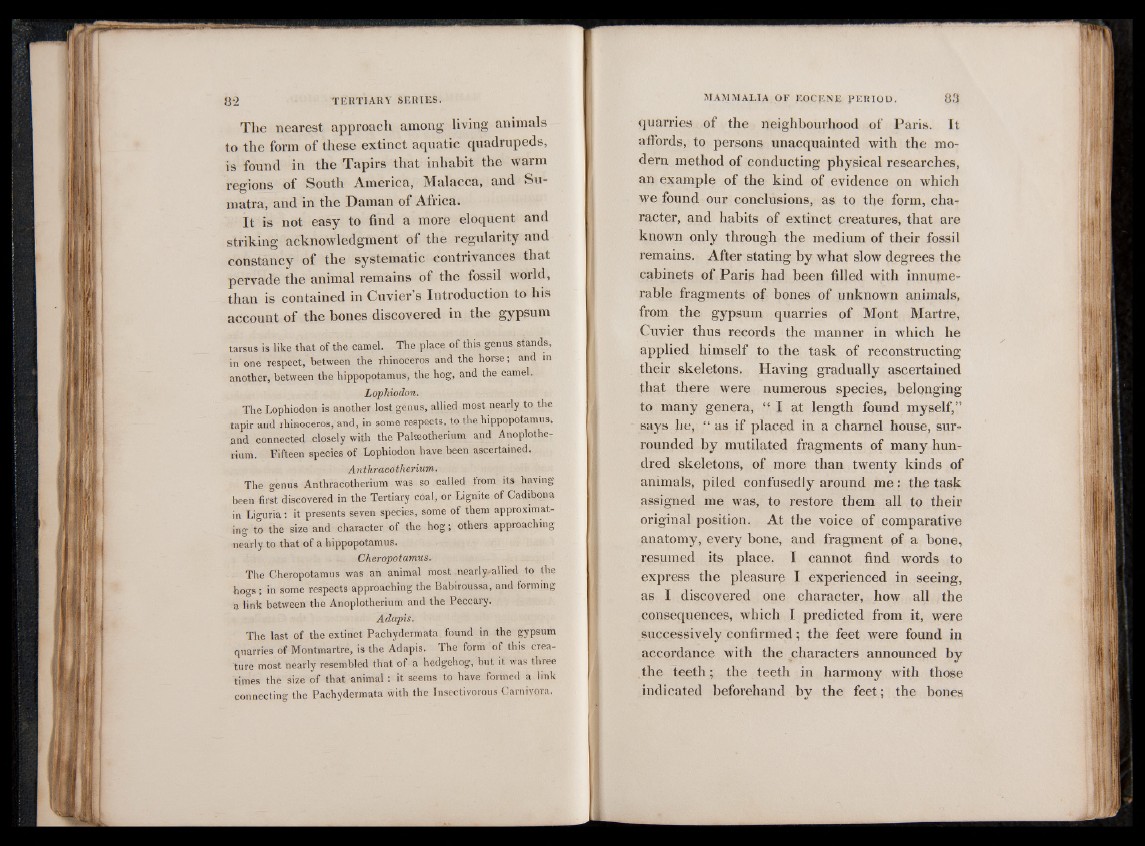
The nearest approach among living animals
to the form of these extinct aquatic quadrupeds,
is found in the Tapirs that inhabit the warm
regions of South America, Malacca, and Sumatra,
and in the Daman of Africa.
It is not easy to find a more eloquent and
striking acknowledgment of the regularity and
constancy of the systematic contrivances that
pervade the animal remains of the fossil world,
than is contained in Cuvier’s Introduction to his
account of the bones discovered in the gypsum
tarsus is like that of the camel. The place of this genus stands,
in one respect, between the rhinoceros and the horse; and in
another, between the hippopotamus, the hog, and the camel.
Lophiodon.
The Lophiodon is another lost genus, allied most nearly to the
tapir and rhinoceros, and, in some respects, to the hippopotamus,
and connected closely with the Palseotherium and Anoplothe-
rium. Fifteen species of Lophiodon have been ascertained,
An thraco therium.
The genus Anthracotherium was so called from its having
been first discovered in the Tertiary coal, or Lignite of Cadibona
in Liguria: it presents seven species, some of them approximating
to the size and character of the ho g ; others approaching
nearly to that of a hippopotamus.
Cheropotamus.
The Cheropotamus was an animal most nearly-rallied to the
hogs ; in some respects approaching the Babiroussa, and forming
a link between the Anoplotherium and the Peccary.
Adapts.
The last of the extinct Pachydermata found in the gypsum
quarries of Montmartre, is the Adapis. The form of this creature
most nearly resembled that of a hedgehog, but it was three
times the size of that animal : it. seems to have formed a link
connecting the Pachydermata with the Insectivorous Carnivora.
quarries of the neighbourhood of Paris. It
affords, to persons unacquainted with the modern
method of conducting physical researches,
an example of the kind of evidence on which
we found our conclusions, as to the form, cha^
racter, and habits of extinct creatures, that are
known only through the medium of their fossil
remains. After stating by what slow degrees the
cabinets of Paris had been filled with innumerable
fragments of bones of unknown animals,
from the gypsum quarries of Mont Martre,
Cuvier thus records the manner in which he
applied himself to the task of reconstructing
their skeletons. Having gradually ascertained
that there were numerous species, belonging
to many genera, “ I at length found myself,”
says he, “ as if placed in a charnel house, surrounded
by mutilated fragments of many hundred
skeletons, of more than twenty kinds of
animals, piled confusedly around me: the task
assigned me was, to restore them all to their
original position. At the voice of comparative
anatomy, every bone, and fragment of a hone,
resumed its place, I cannot find words to
express the pleasure I experienced in seeing,
as I discovered one character, how all the
consequences, which I predicted from it, were
successively confirmed; the feet were found in
accordance with the characters announced by
the teeth; the teeth in harmony with those
indicated beforehand by the feet; the bones